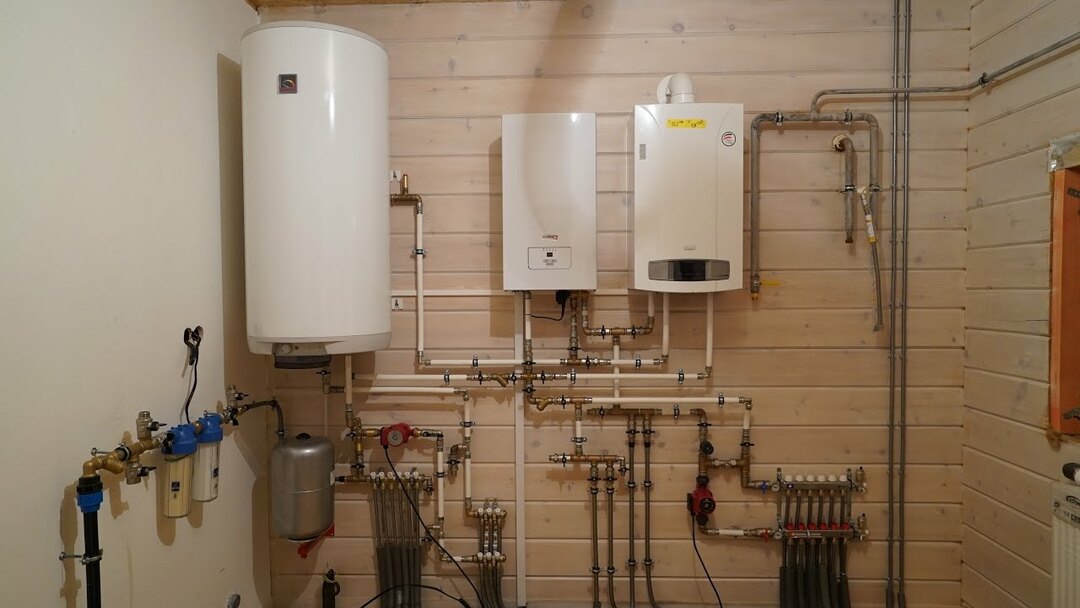The classic heating scheme with one heat generator is well known to every home owner. However, by combining a gas and electric boiler in one system, a much greater practical effect can be achieved. They say that such a connection is much more economical than usual. Sounds tempting, doesn't it?
With logical reasoning, doubts arise: how will electricity help save the budget, because its cost is much higher than gas? And why do this at all from the point of view of the expediency of increasing the power of the units? Isn't it easier to buy just one efficient boiler?
In fact, the project of such a combination is quite justified. We will tell you in detail how to assemble heating with electric and gas appliances. You will learn about the structure of this system and its feasibility. We will help you draw up a diagram and not miss the important nuances of arranging a combined heating line.
The content of the article:
- Why install two boilers at once?
- Shared connectivity
- How to connect 2 boilers in the system?
- Parallel Features
- Manual start / automatic control options
- Hydro arrow in the system of parallel connection
- Conclusions and useful video on the topic
Why install two boilers at once?
The role of the leader in the gas + electro link is usually performed by a gas unit. This is logical if only because of the lower cost of the fuel used in the supply. But the word "save" sounded above, and it is not clear what the cost reduction is.
The fact is that in many regions the tariff for electricity is based on the day / night system. In some cases, it turns out at least quite a bit, but it is more economical than paying for gas. The difference is doubtful, however, it can serve as an additional reason for the accumulation of arguments for the double link.
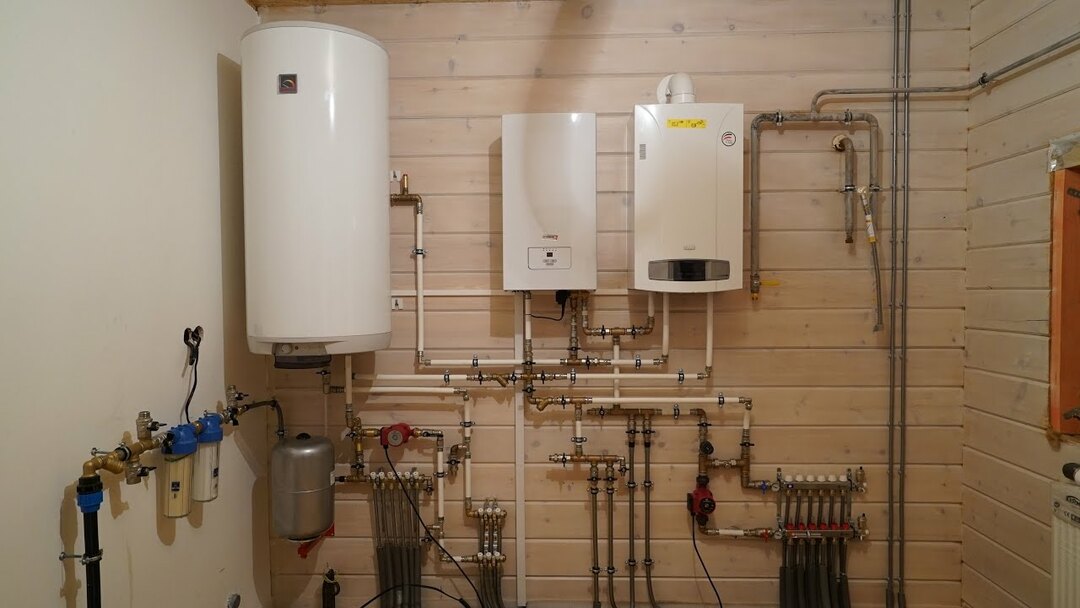
The installation of an electric boiler in conjunction with a gas boiler can play a backup or additional role in the overall organization of heat supply. When choosing the power of the equipment, one should focus specifically on the purpose of its use.
Of course, this is not such a compelling reason to immediately design a heating system with 2 boilers. The main advantages of the circuit are power amplification and uninterrupted operation. When choosing and installing a heat generator, it is necessary to clearly understand that any device and fuel supply will not last forever.
They turn off the power supply, they can cut off the gas main due to a leak, the voltage in the network will drop, or a banal breakdown of the unit itself will occur. In this case, you run the risk of being left without heat and hot water during the cold season.
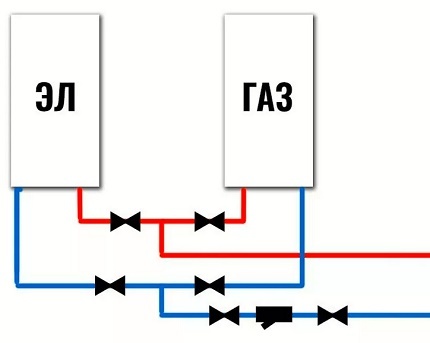
To ensure the uninterrupted operation of heating equipment or to increase the capacity of the system as a whole, it is possible to allow 2 boilers operating on different fuels to operate at once
This is called connecting an additional (for power amplification) or backup power supply, depending on the goals and situations that arise.
Shared connectivity
It is not so easy to design a conventional gas-fired heating system. That is, it is easy to create a working scheme, but it is problematic to get it approved. The situation with electric boilers less deplorable in terms of cost, time and problems with obtaining documents approving the procedure.
And here is the union of 2 multi-fuel units. It would seem that you will not get around problems and you will go to the authorities literally for years, for permits. But this is not the case.
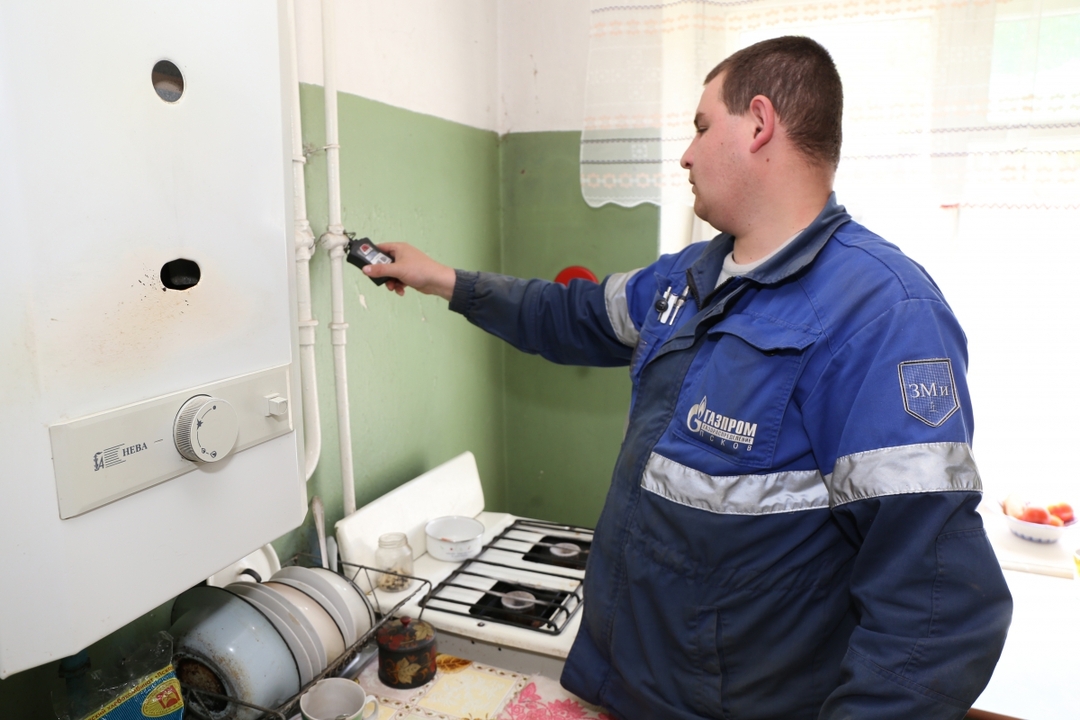
There are no restrictions on the joint use of a gas and an electric boiler in the regulatory documents. However, it is still necessary to agree on such a project with the gas service and obtain permission if you exceed the established limit in the total capacity of the equipment for the use of electricity.
In fact, building codes are quite supportive of such schemes. To be more precise, there are no prohibitions.
Energy and fuel consumption meters are different. The consumption of resources is not exceeded, an explosive situation is not provoked - install the boilers, observing the standard standards, installation instructions for each. There shouldn't be any problems.
We remind you that the installation of gas boilers should be carried out in accordance with SP 402.1325800.2018 (moreover, this document is mandatory, not advisory).
How to connect 2 boilers in the system?
You can't just take and randomly connect 2 devices, the system will either not work, or it will work incorrectly. It is necessary to use carefully designed, competently designed from an engineering point of view.
There are two main connection schemes, these are:
- Consistentwhen all elements are connected to each other without additional nodes. In this case, one device will heat the coolant, and the second will heat it up;
- Parallel, in which the devices included in the circuit have 2 connection nodes and the boilers work independently of each other.
The sequential system is more suitable for low-power boiler installations and is rarely used.
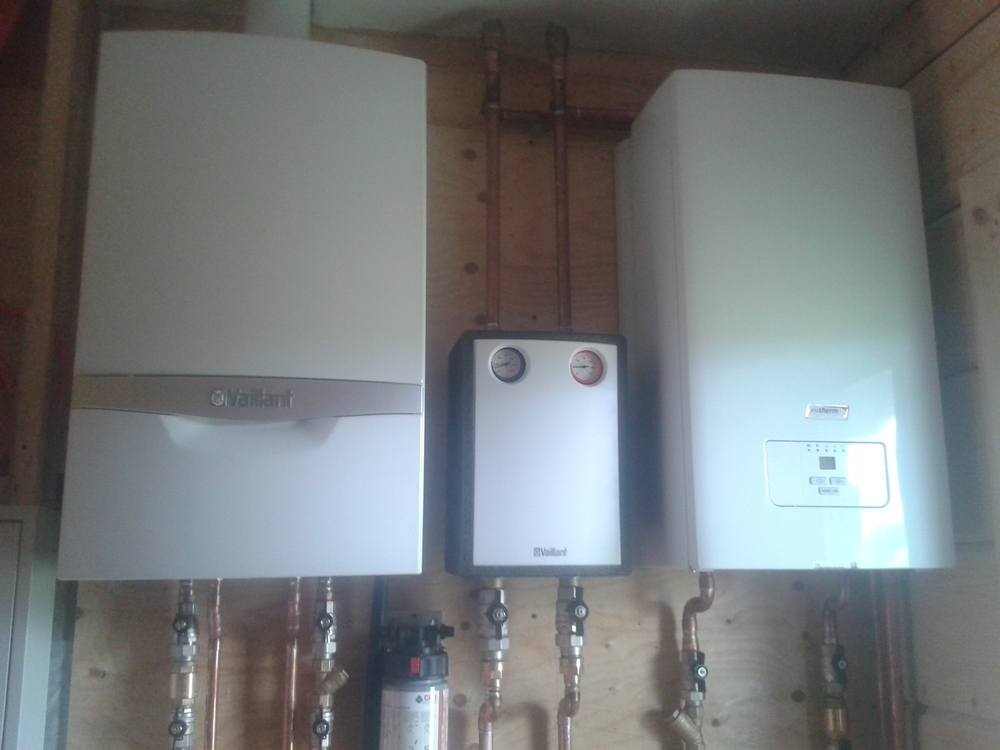
Serial connection is considered impractical if only because it is impossible to remove one boiler without affecting the second. In fact, the problem is solved by installing bypasses and shut-off valves, but still parallel connection is advantageous.
Meanwhile, parallel connection in a single system of gas and electric boilers has a lot of advantages. Therefore, it is it that is used most often, despite the fact that this arrangement requires more materials and is considered more expensive.
In such a device, you can turn off one of the devices at any time and even remove it for replacement or repair, the second will continue to operate normally.
Parallel Features
Let's take a closer look at what a standard scheme for parallel connection of gas and electric boilers looks like:
- Each unit is supplied with coolant supply circuits. They join a common line.
- It is imperative in this case that there are safety groups and shut-off valves.
- The other line is connected to the loops of the return lines, also equipped with shut-off valves.
- On the return line (or at the supply), in front of the unit for aligning the piping contours, it is installed circulation pump.
- The mains of both heating units are connected to collectors.
- One of the distribution manifolds is equipped with expansion tank. A make-up circuit is also connected to its pipe, equipped with a check valve and shut-off valves.
- From the distribution manifolds there are main branches to the underfloor heating, radiators, a boiler, circulation pumps and valves for draining the coolant from the system are installed on each.
This is not a schematic diagram, but only its main features. In general terms, it gives an idea of how best to connect an additional electric boiler to the main gas boiler. The assembly option can be complicated and improved, for example, with an automation system and a servo drive.
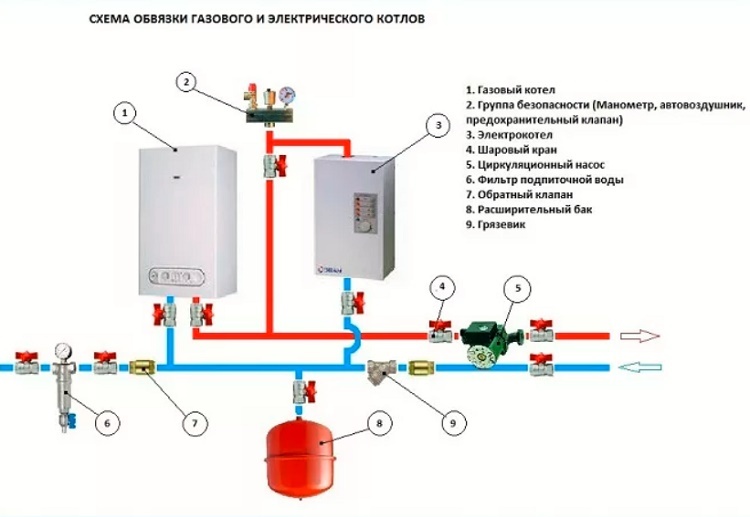
With a parallel connection, you can also install a hydraulic arrow and an automation unit, but before that, carefully consider this solution, their installation is not always advisable
Manual start / automatic control options
The control of the boiler redundancy system or shutdown of the failed ones can be carried out manually or in automatic mode. Leaving the system running with one boiler turned off is impractical, as the water will continue to circulate.
Imagine what will happen when the cooled return flow goes in the opposite direction and starts mixing with the supply, cooling the coolant and forcing the pump to work in vain.
If for some reason you do not want to equip boilers with complex devices, you will start the unit yourself. That is, everything is standard: you need to turn on the device - turn all the necessary valves and turn it on. When disconnecting, proceed in the reverse order.
If you want the standby equipment to be started automatically, the system is equipped with an automatic, thermostats, indoor and outdoor air temperature sensors, coolant temperature sensors, servo drives.
In the schematic diagram of the automatic backup start of the heating unit, all shut-off valves must be in the open position. On the counter scheme, the system is equipped with check valvesto avoid parasitic circulation of the coolant through the boiler that is not working at a certain time.
However, despite the convenience, the system can cause certain problems, for example, the hydraulic resistance of the check valves, which causes stress on the pumps, contamination and wear of the devices themselves.
To automatically turn on the heating boiler, the system is equipped with a thermostat that sends commands to the control unit, depending on the temperature conditions in the house. The switch-on time for night standby use is set on a timer. Circulation pump disconnected with a magnetic starter.
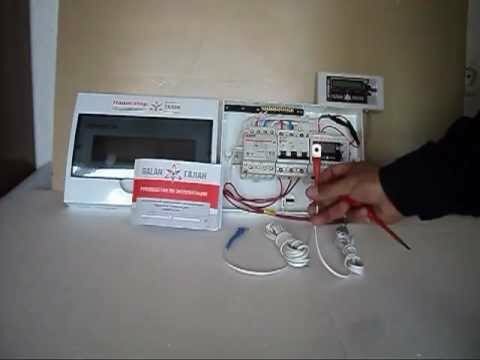
Automation for electric boilers can be built-in, home-made or purchased separately. However, you should not install it with your own hands only on the advice from the Internet, without having the proper skills. Invite the wizard for installation and correct system settings
When choosing a control that will be equipped with an electric boiler installed in parallel with a gas boiler, you should opt for automation, if:
- The reserve boiler is turned on at night, when it is inconvenient to start manually.
- In case of long departures from home during the heating season.
- If the gas boiler is unreliable.
In other cases, it is quite possible to use the simplest manual scheme.
Hydro arrow in the system of parallel connection
Hydrostrelka is a device that provides hydraulic decoupling of flows supplied to individual circuits of the heating system. It plays the role of a buffer tank that receives the flow of the heat carrier heated by boilers and distributes it to consumers in a branched system.
Often the volume of the coolant required for them differs, the speed of movement of heated water and its pressure differ. And in the situation under consideration, the movement of heated water from each of the boilers also stimulates its own circulation pump.
When a powerful pump is turned on, an uneven distribution of the coolant along the circuits occurs. So, the task hydroarrows is to equalize this pressure. Due to the fact that there is practically no hydraulic resistance inside it, it will freely accept and distribute the coolant flows from both boilers.
Let's figure out if it is really necessary in a parallel system for connecting 2 boilers, especially since if buy and install a hydraulic divider with the help of a wizard, and not with your own hands, the total amount unpleasantly surprise.
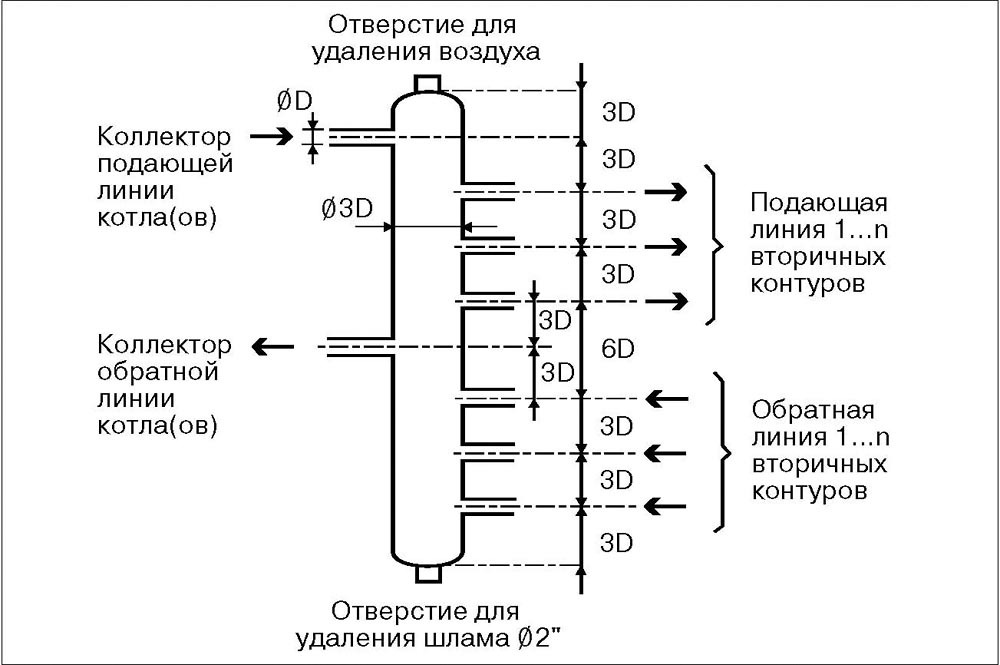
The device is a piece of pipe with nozzles, hollow or with filter nets for removing bubbles and screening out impurities. It can be installed in any position, but more often vertically, equipping the top with an air vent and a shut-off valve for cleaning from below. A hydraulic arrow is installed between the boiler and heating circuits
In the classic connection diagram, a hydraulic separator is usually not required, since a conflict of 2-3 pumps can be leveled without this device. Accordingly, if you have 2 boilers used exclusively as a backup and there are no more than 3-4 pumps in the system, there is no special need for it.
But if the contours with forced circulation more or heating boilers operate simultaneously at power - it is best to install this device. Again, it is not known whether you will use the second boiler permanently or only in standby mode, so it's better to play it safe.
Conclusions and useful video on the topic
Synchronization of operation and shutdown of boilers in a parallel installation:
Installation of 2 heating boilers, gas and electric, is a wise decision to increase the power of heating equipment, as well as for back-up heating of the building. Parallel installation of units is not as difficult as it might seem at first.
The main thing is to correctly select the arrangement scheme and calculate correctly the total or reserve power of the equipment. If you are not confident in your abilities and cannot handle it on your own, it is best to contact a plumber. They will help you quickly and efficiently install the system for a reliable and comfortable heat supply to your home.


